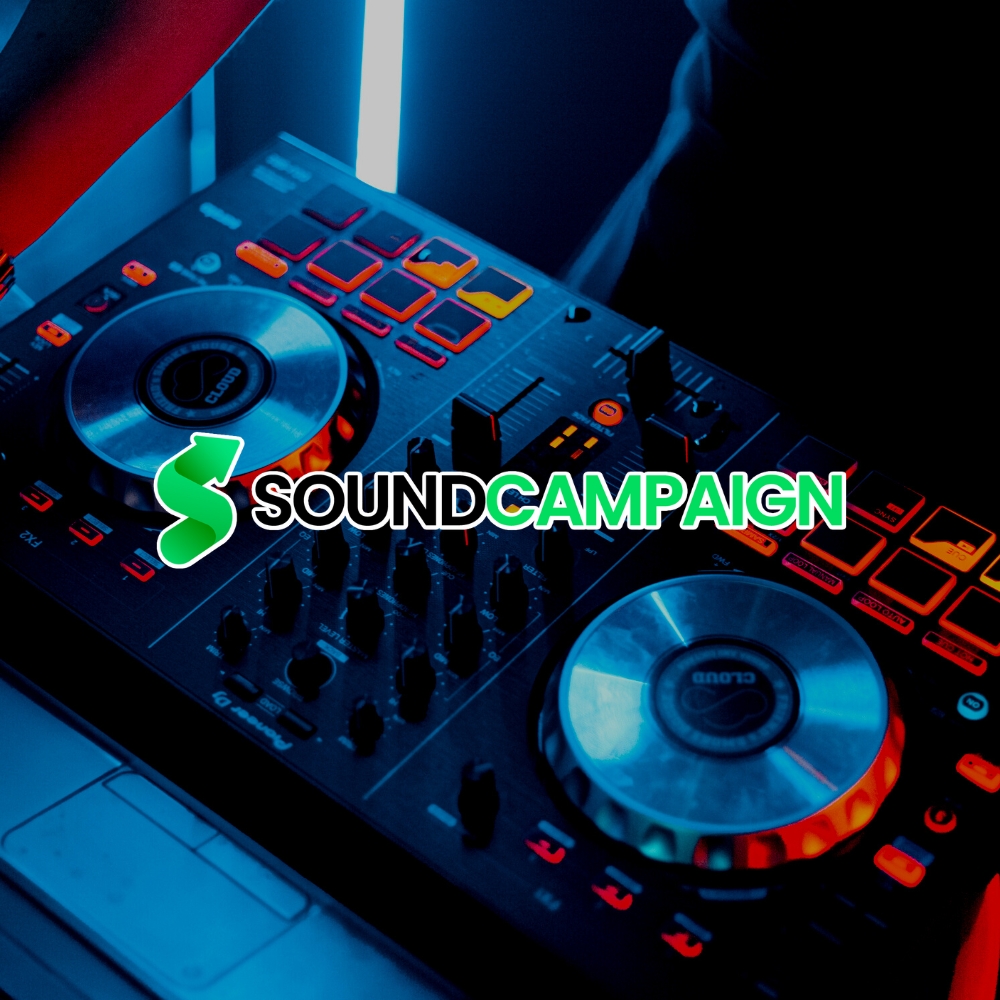It seems likely that if you’ve ended up on this page, you’re considering Spotify playlist promotion – and, more specifically, you’re wondering whether SoundCampaign is worth your time and money. If that’s true, it’s also likely the case that you’re feeling a little overwhelmed digging through all of the information out there on the wide world of the internet.
There’s a lot of noise out there, so I’ll try to cut to the chase.
Is SoundCampaign’s Spotify promotion legit?
My short answer is: Mm, maybe.
Sorry ha. I know that really wishy-washy, but it’s my honest take.
I recently ran my first campaign with them. My results were poor, but the process was solid. I came away disappointed, but convinced that the company itself is legitimate, and I have a hunch that this model has a high ceiling. There’s no guarantee of a number of streams for a given spend, but I do think it’s possible that certain songs could do very well on the SoundCampaign platform. It’s also possible, as I found out, to get disappointing results.
So, like I said – mm, maybe.
If you want to give your own song a shot…
Here’s the link to try SoundCampaign.
(Heads-up – that’s an affiliate link, so I’ll get a small commission if you decide to try their promo.)
And if you want to read more detail on the campaign results, as well as get my breakdown on the promotion, that’s probably a good call.
Let’s get into it.
The background on my SoundCampaign promotion
I’ll start by giving you the background story, because I think that’ll put this campaign in its proper context. (If you don’t care about this and just want to see the results, no worries – just hit this link.)
So, the background: I was born in the cold fall of 1992, only a few short weeks after the Pittsburgh Pirates lost to the Atlanta Braves in the NLCS. From an early age, I was interested in music; I can still remember playing around on the upright piano that my parents kept in the living room of our old home…
Kidding, kidding. I’m not actually going to give you that much backstory. Let’s skip ahead a few years, all the way to 2019.
That’s the year I started experimenting with playlisting services before eventually publishing a piece on the top Spotify promotion companies. The article immediately started ranking pretty high in Google search results, and as a consequence, I started getting promotion companies reaching out to me and asking to be included on my list.
SoundCampaign was actually one of those companies:
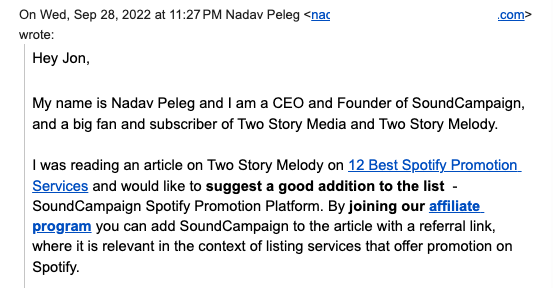
That came in through my website contact form, and, to be honest, I totally ignored it. I was busy toward the end of 2022, and this just slipped through the cracks.
But a few short months later, toward the beginning of 2023, I decided to update my Spotify promotion post by re-trying 15 different companies, including several that I hadn’t tried before. That’s when I remembered that SoundCampaign was a thing, and decided to give it a try.
SoundCampaign’s approach (a quick overview)
There are a few different models that playlisting agencies tend to follow. I’m planning to break them down in more detail soon, but for now, I wanted to note how SoundCampaign works.
Basically, they have an open network of playlist curators, which anyone can apply to join. If you get accepted as a SoundCampaign curator, you’ll be sent music that matches your genre preferences, and you’ll be paid to review submissions. On the artist side, you can choose how many curators to send your music to (sending to more curators costs more money), but you can’t select individual curators to pitch specifically.
This is a bit different from how companies like Indie Music Academy, Moonstrive Media, and YouGrow operate – those services use smaller, closed curator networks that typically feature large, SEO-built playlists. SoundCampaign, by contrast, has more curators and more niche genres, but their playlists tend to be smaller.
It’s also different from how SubmitHub and Groover work, in that SoundCampaign doesn’t let you select specific curators to pitch. However, they do show you curator responses and allow you to reply.
If you’re familiar with PlaylistPush, this is pretty much the same model. It can work really well – at least, I’ve run great campaigns on PlaylistPush. But this model’s success is heavily dependent on the quality of the curators and on the platform’s ability to match you to the right ones (since you don’t have control of that yourself).
Okay – with all of that said, let’s get into my actual campaign and its results.
The SoundCampaign setup
As I mentioned above, I tried SoundCampaign as part of my experiment with 15 different promotion companies.
To make it happen, I emailed my list and asked for artists to submit songs they’d be willing to test. That’s how I got connected to dweller.
They’re a band from Brooklyn, New York, who make what I’d call “grunge pop” and what Spotify apparently categorizes as “5th wave emo,” whatever that means. (Maybe I should know, but I definitely don’t.)

Anyway, their song “Night Theater” has a moody guitar line that I kind of love and some half-scream, angsty vocals that fit it perfectly.
I thought it’d be an interesting one to try playlisting with, so we gave it a shot.
SoundCampaign’s setup wizard starts by asking you to select a song to promote. Once you do that, they’ll ask you to create an account with them. I did, and from there I was into a cool little dashboard area.
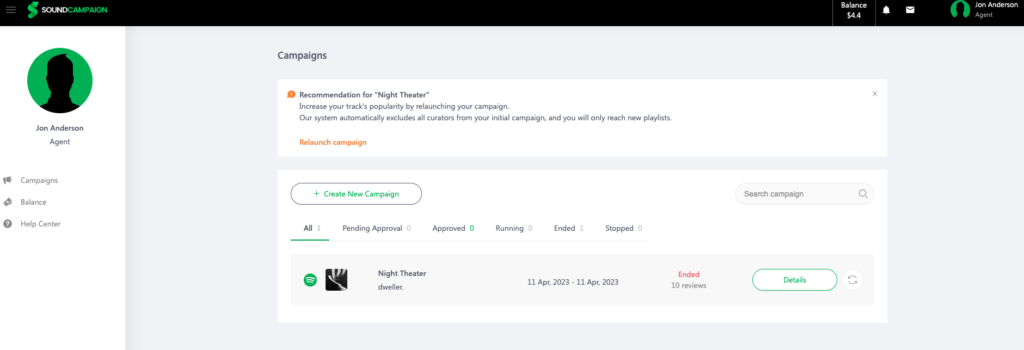
One thing that I liked about SoundCampaign was that they wouldn’t let me create a campaign until they’d reviewed the track that I’d submitted.
Ostensibly, that helps keep song quality high for their curators and also ensures that artists only pay if SoundCampaign thinks they’ll get results. I’ve read reddit reviews from curators saying that, in practice, the quality of the songs they receive from SoundCampaign actually isn’t great, so who knows, maybe they approve everything – but on the front side at least, it’s an approach that I very much respect.
Regardless, I got an email notifying me that “Night Theater” had been approved a couple of days after I’d submitted it.
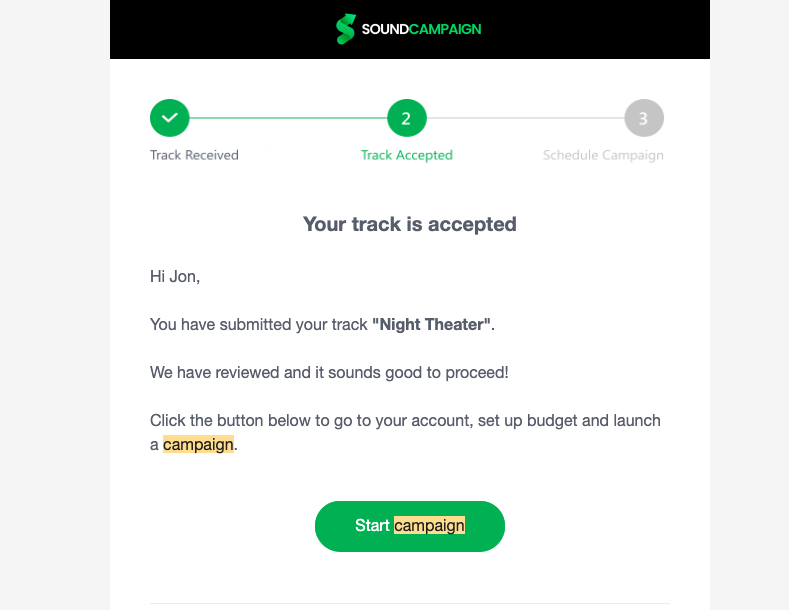
And with that, I walked through the rest of their campaign setup wizard.
The first step is to pick the genres your song matches. They’ve got a fairly extensive list, but it’s completely dependent on you to get the selection right; other platforms, like PlaylistPush, auto-pull genres and similar artists from Spotify to determine which curators to send to, but SoundCampaign relies on your ability to apply your own labels to your music.
SoundCampaign didn’t give me the option to go quite as granular as Spotify had suggested, so I went with five close-ish genres.
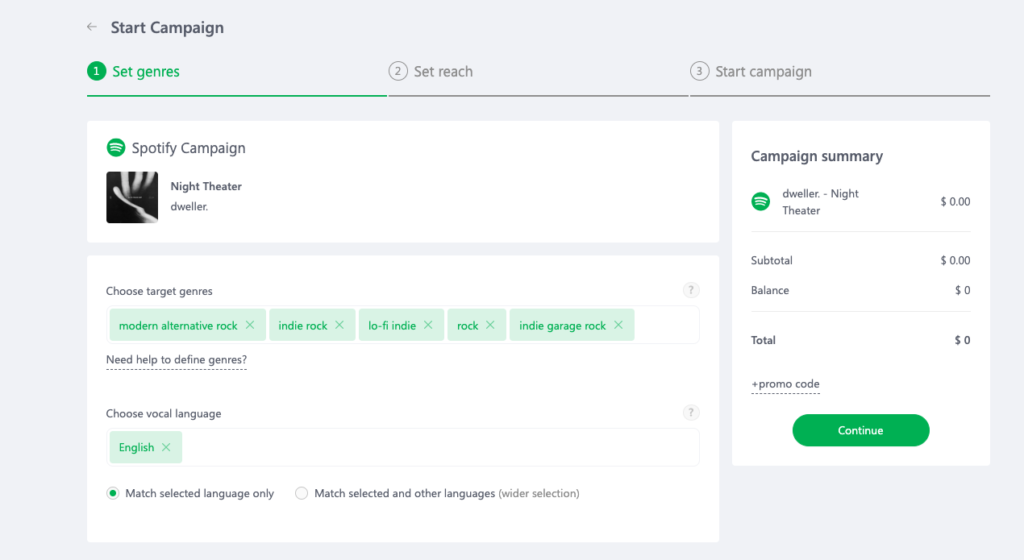
From there, you’re prompted to set your reach – in other words, the amount of money that you’ll spend and the number of curators you’ll send your track to. They auto-prompted me to spend $370 to reach about 38 curators, but I dragged it down to spend close to $150 so that I’d reach an estimated 21.
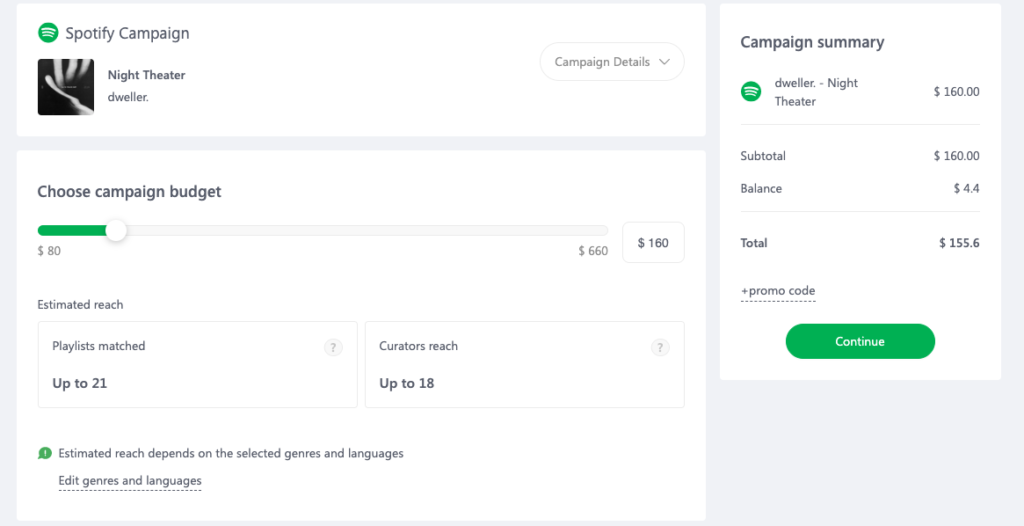
And that’s about it – the final step is to submit payment, and from there, you pretty much just wait for the results to roll in.
Here’s what happend.
SoundCampaign promotion results
Over the course of about a week, responses from curators came in. As it turns out, we were sent to 10 curators rather than the estimated 21, and we ended up getting approved by two of them. In my experience, that’s a pretty common approval rate; SubmitHub’s, by comparison, is right around 20% on average.
We could see the reply from each curator in the dashboard and were given the option to rate it (I didn’t rate any). There’s also an option to reply to each of them, which is nice (and something which PlaylistPush doesn’t have).
As a curator myself, I always take these responses as virtually meaningless – 50 songs in, it gets hard to structure coherent feedback, and it’s not like these curators are necessarily audio engineers, anyway – but I do appreciate the effort.
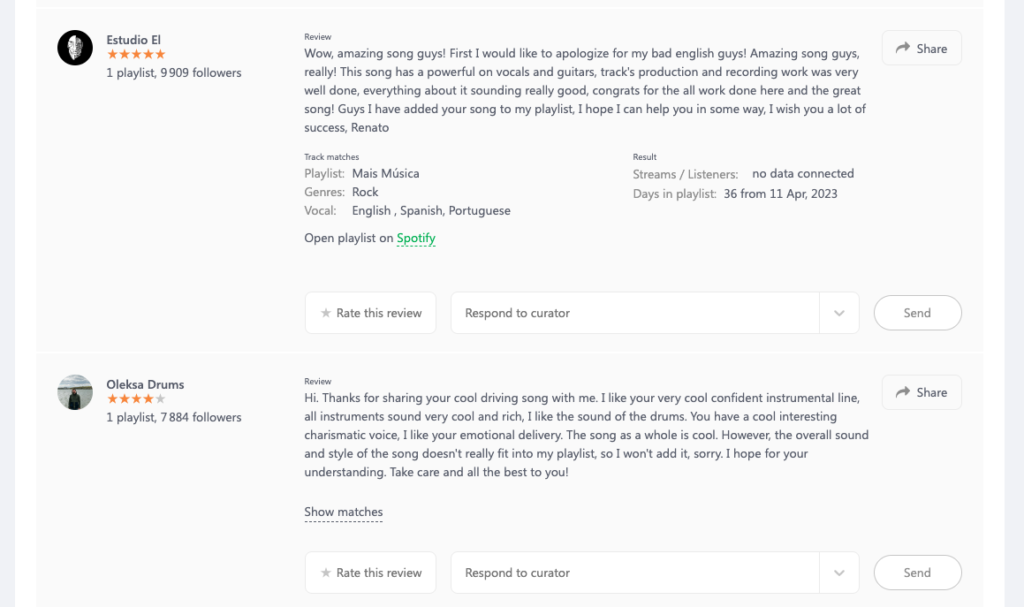
You can see one of our approvals in the above image; the other approval of our two was in a playlist called Talkish Rock-ish.
Here are both the playlists we were placed in, if you’re interested in checking them out for yourself.
Genre-wise, these are fine. Talkish Rock-ish is kind of a fit. Mais Música is super broad, though – I’m not sure “Night Theater” belongs next to “Thinking Out Loud,” but hey, you can’t always account for taste.
Neither of these lists were huge, but they both had decent follower growth curves.
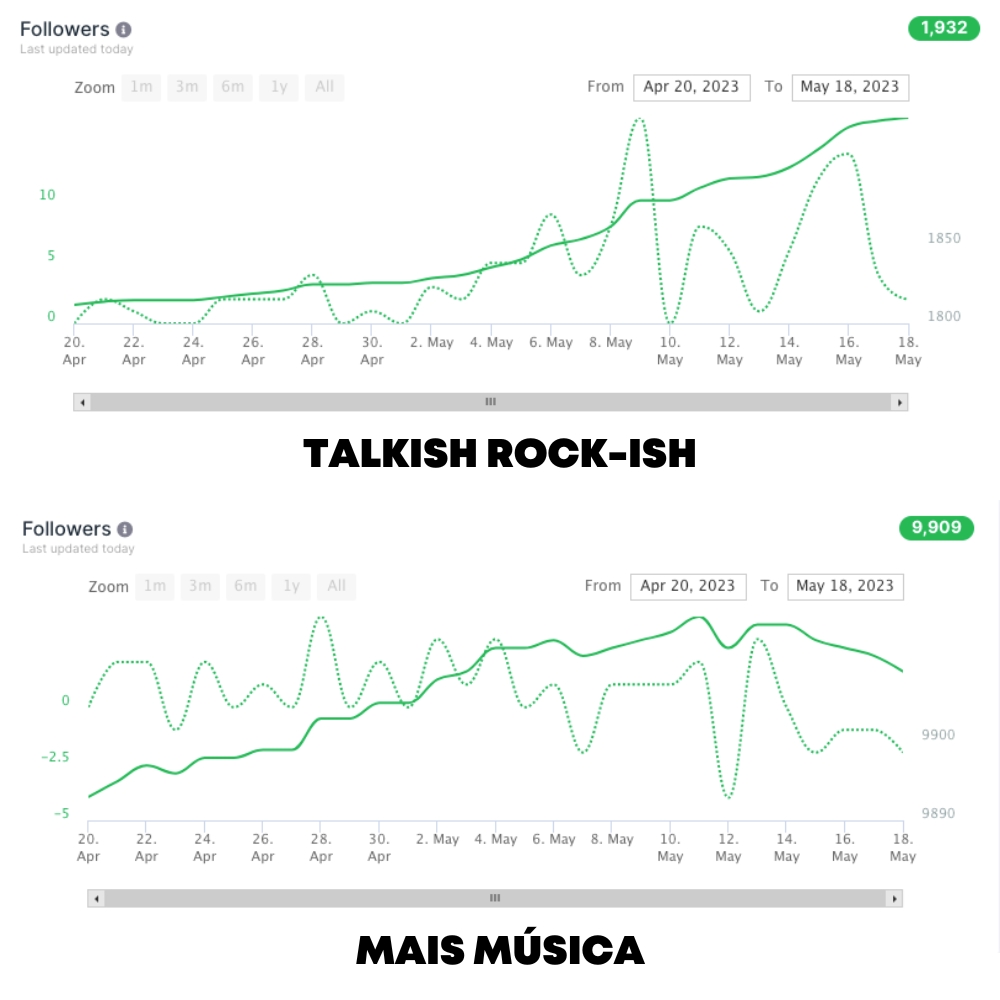
You can see a few bumps in the Mais Música list, but it doesn’t look fishy to me; the most followers that dropped in a day was only four, which seems more like natural churn than the result of Spotify clearing out bot accounts (usually if a curators has been buying bot, dips happen by the hundreds).
If I had to guess, I’d say that both of these playlists have been built with ads, and that the recent downturn on Mais Música is due to the curator pausing ad spend. Overall, these are decent lists – not huge and not hugely impactful, but also probably natural (i.e., filled with real people).
On the Spotify for Artists side of things, the data bears that out.
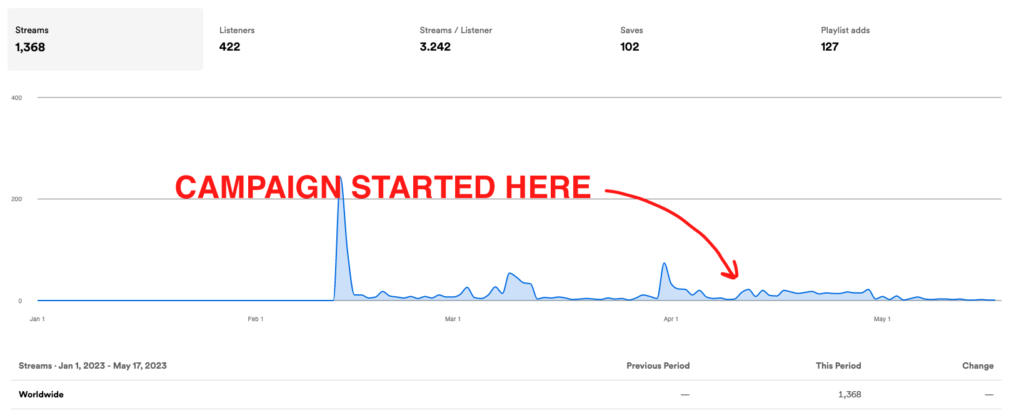
We didn’t get too many streams, but we did get a few, and both of our playlist placements ended up on the song’s top three all-time, sandwiched around Spotify’s algorithmic radio lists.

All told, that comes out to 188 streams for $155 – so, like $0.83 per stream.
Honestly, that’s not great, especially for playlisting. (My recent campaign with YouGrow, by comparison, was at about a tenth of a cent per stream.)
And there was no long-term algorithmic boost that we could see, either.
Campaign analysis: the pros and the cons of SoundCampaign
So, what’s it all mean? Great question. Here’s my breakdown, starting with the drawbacks first.
The cons of SoundCampaign
1. The results from my campaign were uninspiring.
Again, $0.83 per stream from a playlisting campaign is a disappointment.
There are plenty of potential explanations for the underwhelming performance; I might’ve selected the wrong genres, for example, or it could simply be that the song wasn’t a good fit for SoundCampaign’s network of curators.
(It’s probably worth noting here that some reviewers have criticized SoundCampaign’s distribution process, meaning the way that songs are sent to curators for review. I have no way of determining how effective their system is, so I won’t comment. But I do think on a personal level, I prefer PlaylistPush’s method, which auto-pulls Spotify data to guide your submission.)
On a platform like this, there’s a lot of room for variance, because they’re just sending your song out rather than guaranteeing any sort of specific results.
For reference, I’ve run SubmitHub and PlaylistPush campaigns that have gotten literally zero placements and streams – and I’ve also run campaigns on those platforms that have been incredible. So one bad campaign isn’t necessarily indicative of the platform being a total bust.
But it’s definitely not proof that the platform is awesome, either, so it’s got to be a con.
2. SoundCampaign is risky in that you may get zero or no results.
This is basically what I said above, but I wanted to break it out in case you’re skimming.
There’s no guarantee that your song will get any placements or streams, and if you do get placements, there’s no guarantee that they’ll be impactful.
SoundCampaign attempts to negate risk by reviewing every submission, but, ultimately, with the way their model works, you’ll always be rolling the dice.
The pros of SoundCampaign
Despite my campaign’s lackluster performance, I do think there are a few good things about SoundCampaign.
1. From what I can tell, their playlists are legit.
Out of the 14 other Spotify promotion companies I tried, one used clear bot-built lists and one used a sketchy form of advertising that made the data look really unnatural. So legit playlists definitely aren’t something to take for granted. Again, I only had exposure to 10 playlists (and was only placed on two of those), but all of the ones I checked out were seemingly healthy – meaning they seem to be built with real listeners, not bots.
That’s a good thing.
2. The SoundCampaign model has a high ceiling.
In other words, if a campaign goes well with SoundCampaign, it has the potential to go really well.
Closed-network agencies, like Indie Music Academy or Moonstrive Media, are more dependable, but they also tend to have lower ceilings, because once the company gets you onto a specific list, they stop pitching, knowing they’ve gotten their guaranteed results.
SoundCampaign, like PlaylistPush and others, works differently; it gives you the potential to hit a homerun. You could conceivably spend $150 bucks and get on 10 playlists, including some very engaged, highly impactful ones, and end up with a ridiculously low cost-per-stream.
And because it doesn’t rely solely on SEO-built lists, it may actually be able to drive higher-fit placements. (SEO-built lists are often big because they’re broad – which drives a lot of plays, but can also result in lower engagement rates.) Obviously it didn’t happen for my campaign, but if you hit with a high number of high-target lists, that’s a recipe for triggering the algorithm.
This is the flip side of the higher risk – the reward is potentially higher, too.
3. The system is really easy to use.
I like the dashboard, and I liked the fact that I could reply to curators (which, again, is impossible on some other platforms). While I think auto-pulling data from Spotify might help with the effectiveness of submissions, from an interface perspective, this was about as streamlined and easy a submission process as I’ve seen.
Their customer support seems solid, too. I didn’t have any issues, but their campaign manager was proactive in keeping me in the loop. I give bonus points for that.
Final thoughts on SoundCampaign
Overall, I think SoundCampaign deserves a spot on my list of top Spotify promotion services thanks to the legitimacy of their model, but my campaign wasn’t effective enough for me to give them a high rating.
They’re a solid company, and I think it’s possible that you could run a campaign with them and get phenomenal results. My own test did drive a few legitimate streams, but overall the numbers were disappointing for the money I spent.
But hey – that’s playlisting. Even with companies that maintain a higher degree of control, it’s high-risk, high-reward.
I think there’s a decent chance I’ll try SounCampaign again to see if I can hit the better side of that spectrum; if I do, I’ll update this post. In the meantime…
If you want to give SoundCampaign a shot, here’s the link again.
And regardless, here’s hoping you find encouragement to keep making your music and putting it into the world. Remember, numbers aren’t everything. Your music matters. That’s true whether you get a million streams and trigger the algorithm – or not.
Either way, here’s wishing you good luck.

